Translators of Jewish texts
10 unforgettable translators of Jewish texts
By Yehuda Shurpin From Chabad

Moses
Not only did we receive the Torah from G‑d through Moses, but our sages tells us that Moses was the first one to translate the Torah as well. Just weeks before his passing (on his 120th birthday), on the first day of the 11th month (Shevat), Moses reviewed the Torah and translated it into the 70 languages that existed then.
Commentaries explain that although the Jews at the time had no need for the translation, and didn’t even necessarily know those languages, they would eventually be exiled and scattered among the nations. Moses translated the Torah into all languages to indicate that no matter where they would be or what language they would speak, the Torah would be relevant to them.
Read: Is it Torah If It’s Not in Hebrew?
Onkelos the Convert
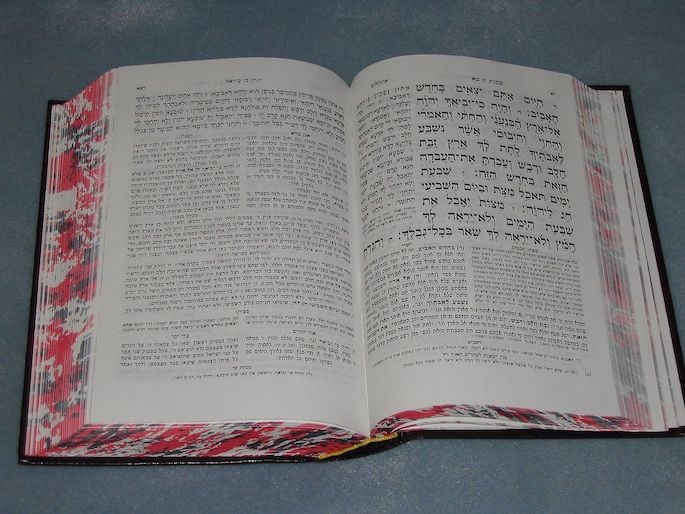

In this standard edition of the Five Books of Moses with commentary, one can see the translation of Onkelos to the immediate left of the main Hebrew text.
Onkelos was the nephew of the Roman Emperor Titus (according to another opinion, Hadrian), and converted to Judaism (circa 81 CE). When his uncle learned of his conversion, he sent a number of emissaries to dissuade him, but not only were they not successful, Onkelos ended up persuading the Roman messengers themselves to convert. Ultimately his uncle gave up.
Onkelos became a student of the leading sages of his day, Rabbi Eliezer and RabbiYehoshua. When Onkelos saw that many Jews had forgotten their holy language, he decided to translate the Torah into Aramaic. The Talmud points out that the translation already existed at the time of Ezra the Scribe, but it had been forgotten among the people, and Onkelos recorded it so it would not be forgotten again.1
Onkelos’s translation is often referred to simply as targum (“translation”), and is printed alongside most editions of the Chumash.
Read: Onkelos
Jonathan ben Uzziel
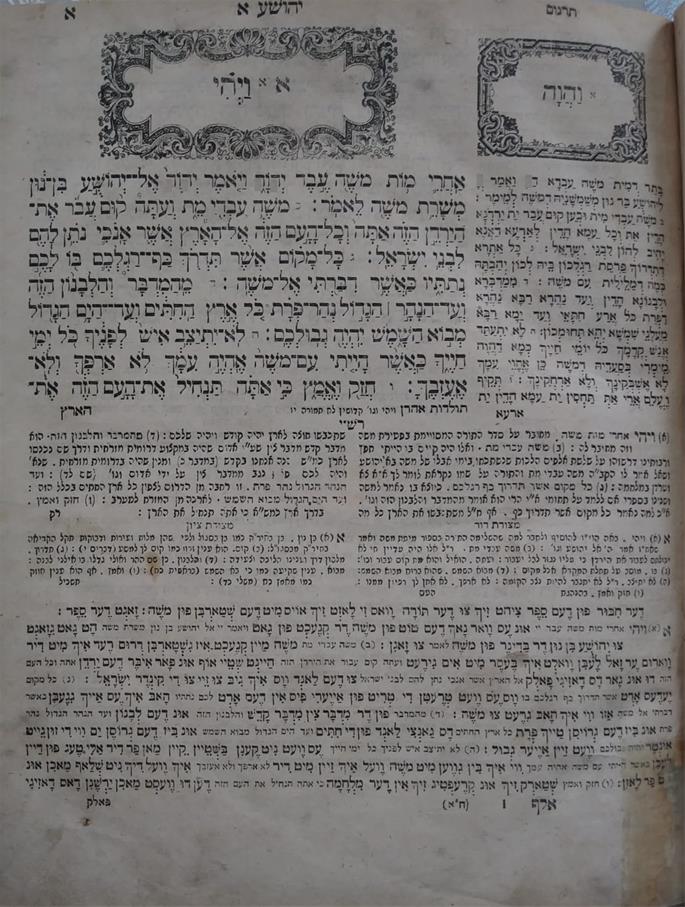

In this edition of the Book of Joshua with classic commentaries and Yiddish translation, the Aramaic rendering of Jonathan appears directly beside the text.
Jonathan ben Uzziel (1st century CE) was considered the greatest of Hillel the Elder’s students.
Jonathan ben Uzziel wrote his translation of the Prophets based on traditions going back to the prophets Haggai, Zechariah and Malachi. Unlike the translation of Onkelos, Jonathan’s translation includes select elucidations and commentary as well.
There is also a translation of the Five Books of Moses attributed to Jonathan. However, the Talmud mentions only his translating the Prophets. As such, many are of the opinion that the translation printed in some Chumashim under his name, while also from around that era, was not actually authored by him.2
The Talmud tells us that when he wrote his commentary on the books of the Prophets, the Land of Israel trembled and a heavenly voice called out: “Who has dared to reveal My secrets to mortal men?” Jonathan ben Uzziel then arose and declared: “I am the one responsible for revealing Your holy secrets to mankind. But not to do myself honor, nor for the glory of my ancestors, did I do this, but solely so that the Jews may understand what the Prophets have told them.”
He originally intended to translate the Ketuvim (Writings) as well. When he was about to write it, a heavenly voice called out, “You have done enough,” lest he reveal the secret of when the Messiah is meant to come, which is hidden in the book of Daniel.3
Read: Jonathan ben Uzziel
Rabbi Saadiah Gaon
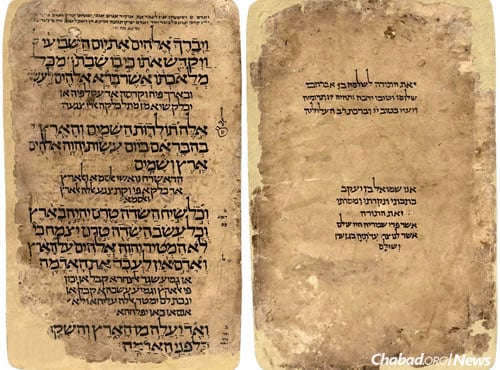

This handwritten edition features vowelized Hebrew verses (in large type), followed by Arabic translation (in smaller type), formatted to be used in the weekly review of the Torah portion as per the ancient custom of chanting the original Hebrew two times and a translation once.
Rabbi Saadiah Gaon (882–942) authored many works, including writings on Jewish philosophy, grammar and Jewish law. Perhaps his most famous work was Emunot Vede’ot(“Beliefs and Opinions”), the first systematic treatment of Jewish philosophy, written in Judeo-Arabic.
What is perhaps less known is that he authored an Arabic translation and commentary of the Torah known as the Tafsir (Arabic for “biblical commentary”).
His commentary on the Torah is divided into two parts: 1) Peirush Hakatzar (“The Short Commentary”), the translation of Tanach into Arabic, including some brief explanations. 2)Peirush Ha’aroch (“The Long Commentary”), which includes discussion and analysis of linguistics, halachah and philosophy.
Read: Rendering an Epic Commentary into Modern Arabic
Ibn Tibbon Family
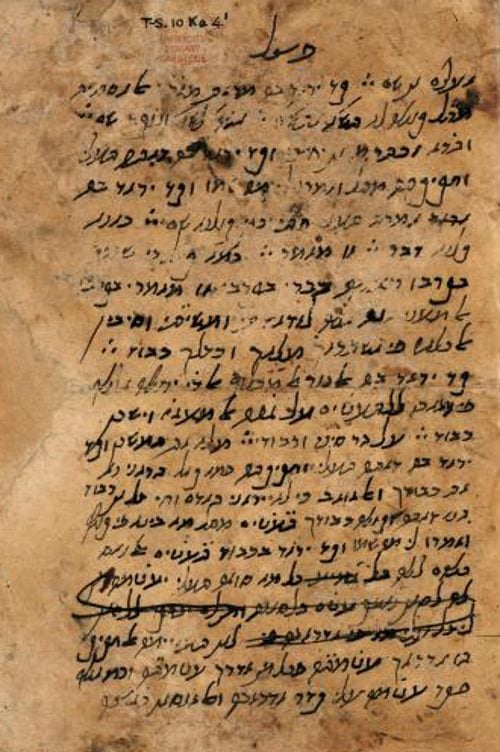

A page from an early draft of Maimonides’s “Guide for the Perplexed.”
In earlier generations, books needed to be translated from Hebrew into other Semitic languages. Eventually the pendulum swung the other way. Jews migrated to Europe and could not read Arabic, so Hebrew once again became the lingua franca of the Jewish world. This brings us to the ibn Tibbon family.
The ibn Tibbon family lived in southern France during the 12th and 13th centuries. Their translations of some of the most classic Jewish works into Hebrew from the original Arabic made these works accessible to the wider Jewish audience.
Judah ben Saul ibn Tibbon (1120–c. 1190) was the first in this illustrious line of translators. In addition to authoring his own works, he is best known for translating classic works such as Rabbi Saadiah Gaon’s Emunot Vede’ot (“Beliefs and Opinions”), Rabbi Bahya ibn Paquda’s Chovot Halevavot (“Duties of the Heart”) and Rabbi Yehuda Halevi’sKuzari.
Shmuel ibn Tibbon (c. 1165–1232), like his father Judah, was a merchant and translator. He is perhaps most famous for rendering Maimonides’s Moreh Nevuchim (“Guide for the Perplexed”) into Hebrew. He also translated smaller works of Maimonides, such asShemoneh Perakim (“Eight Chapters”), his commentary on Avot, Iggeret Techiyat Hameitim (“Letter on Resurrection”) and Iggeret Teiman (“Letter to Yemen”).
During the course of his work of translating Guide for the Perplexed, he consulted and corresponded with Maimonides regarding some difficult passages. Maimonides responded with praise and gave some guidelines for translating his work.
Moses ibn Tibbon (fl. 1244–1283), son of Shmuel, was a physician, and followed the family tradition of both authoring original works as well as translating various works into Hebrew. He is perhaps most famous for his translation of Maimonides’s Sefer Hamitzvot(“Book of Commandments”) into Hebrew.
Rabbi Yaakov ben Yitzchak Ashkenazi
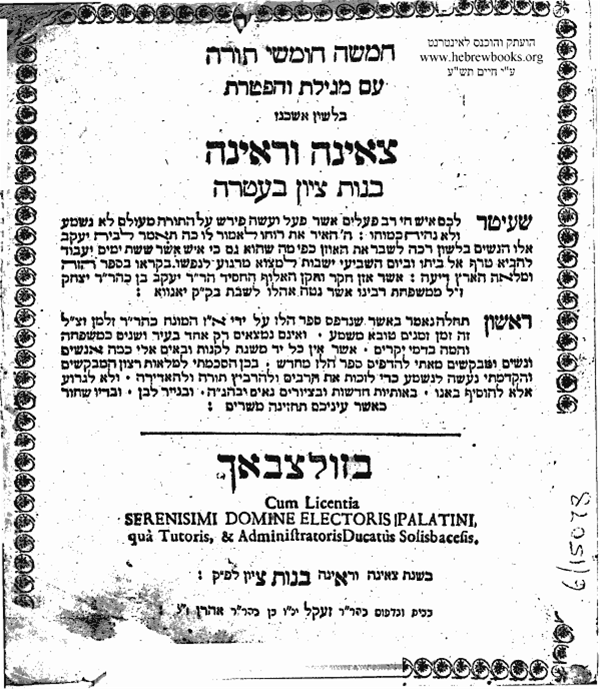

Tze’enah Ure’enah was printed and reprinted dozens of times. This edition was printed in Sulzbach in 1789. (Image: YIVO Institute for Jewish Research)
Rabbi Yaakov ben Yitzchak Ashkenazi (1550–c. 1625) lived in Janów, Poland. Although most Jewish works at the time were written in Hebrew, the common spoken language among Jews was Yiddish (see Why Do Jews Still Insist on Speaking Yiddish?). As such, Rabbi Yaakov wrote a work called Tze’enah Ure’enah. In addition to translating the weekly Torah portions and haftarahs into Yiddish, it mixes biblical passages with translations of teachings from the Talmud, Midrash and commentaries on the verses. Until recently this was common in Jewish homes, and often served as the base for women’s study groups.
Rabbi Yosef Qafih (Kapach)
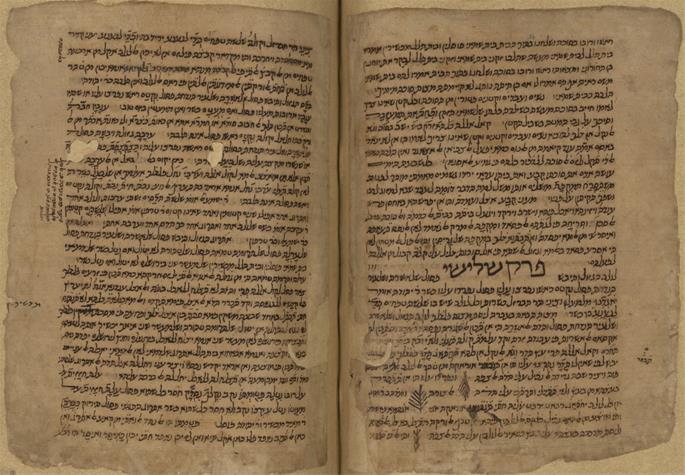

Maimonides’ commentary on the Mishnah in the original Arabic, written in Hebrew characters.
Rabbi Qafih (1917–2000) was born in in Sana’a, Yemen. He eventually emigrated to Mandatory Palestine (Israel) in 1943. A leading scholar on Jewish law and thoroughly proficient in both Hebrew and Arabic, he found many of the earlier translations of classic Jewish works wanting. Additionally, he was in possession of what are said to be Maimonides’s own manuscripts. As such, he set about creating new translations of many of the classic Jewish works, including Book of Beliefs and Opinions, Duties of the Heart,Kuzari, Guide for the Perplexed, Sefer Hamitzvot and Maimonides’s commentary on the Mishnah. He translated some works from Arabic to Hebrew for the first time. Included with many of his translations is his own commentary culled from various commentators. His translations are considered by many to be the definitive translations of these works.
Rabbi Aryeh Kaplan
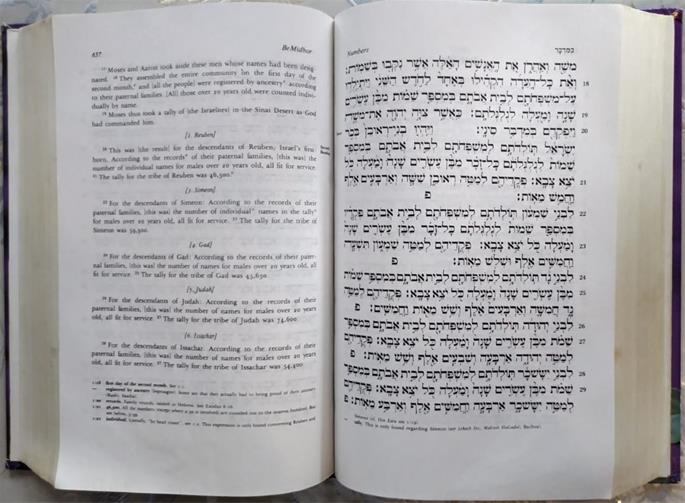

The Living Torah provides a translation that is accessible to the beginner and enlightening to the accomplished scholar.
Rabbi Aryeh Moshe Eliyahu Kaplan (1934–1983) was born in the Bronx, New York, to a nonreligious family of Sephardic descent. (The family name was originally Carmona, after a city in southern Spain. His grandfather, upon arriving in the United States around the turn of the century, changed the name to the more Ashkenazic-sounding Kaplan.) His mother died when he was only 13, and he attended synagogue to recite Kaddish for her. A chassidic teenager noticed that he was out of place, not wearing tefillin or even holding asiddur, and befriended him. Eventually he went on to embrace Jewish observance and to go to yeshivah as well as university, becoming proficient in both physics and Kabbalah. He authored over 50 works, including introductory pamphlets on Jewish beliefs and philosophy. He is equally famous for translating many works into English, including the Kabbalistic works Sefer Yetzirah (“Book of Formation”) and Sefer Habahir (“Book of the Bright”), as well as the Five Books of Moses (under the title Living Torah).
He is also famous for his translation of the classic work Me’am Lo’ez by Rabbi Yaakov Culi (d. 1732), which was originally written in Ladino (Judeo-Spanish). The work is mostly written as a commentary on the Torah, but includes Midrash, Talmud commentary, relevant halachah, and other areas of Jewish thought. Me’am Lo’ez had been previously translated into Hebrew, but Rabbi Kaplan taught himself Ladino in order to translate this monumental work straight from the original. This 45-volume work is known as the Torah Anthology.FOOTNOTES1.
Talmud, Megillah 3a.2.
See Shem Hagedolim, Maarechet Sefarim, s.v. “Targum Yonatan.”
For more on this story go to; https://www.chabad.org/library/article_cdo/aid/4410868/jewish/10-Unforgettable-Translators-of-Jewish-Texts.htm#utm_medium=email&utm_source=1_chabad.org_magazine_en&utm_campaign=en&utm_content=content






For me, this is an interesting article that interprets the history of the translation of the Torah in the context of the exile and dispersion of the Jewish people. The translation of the Torah into different languages symbolizes the preservation of the spiritual and cultural heritage of the Jewish people, regardless of their location and the language they speak. My work also involves the study of various kinds of documents, so the document translation is often important. Covering more than 60 languages, the resource, if necessary, translates up to 5 language pairs per order. For me, these are document translation services at a reasonable price, so I always cooperate with this resource and am satisfied with the quality of translation.